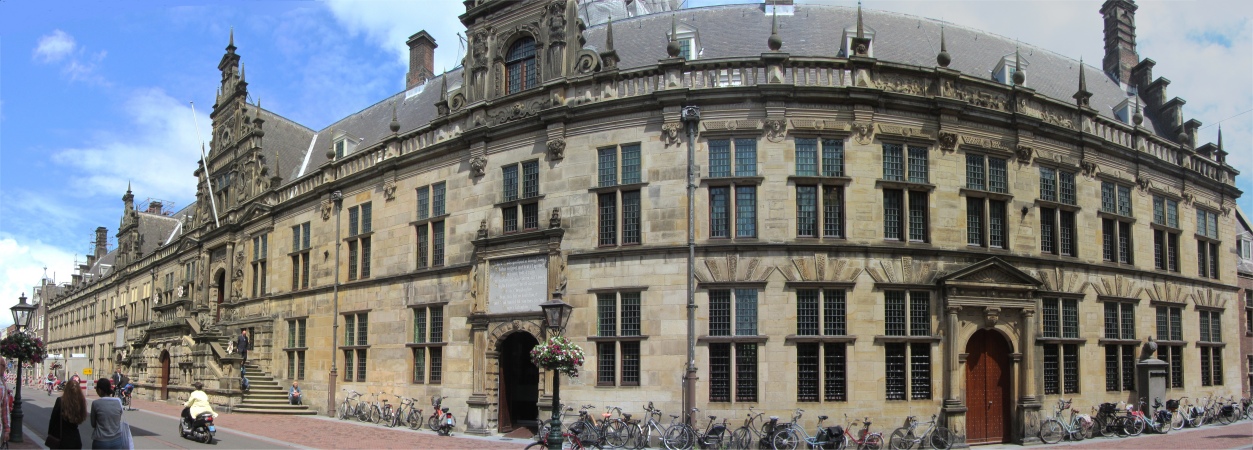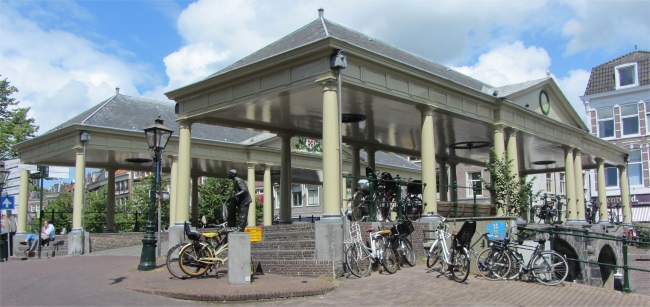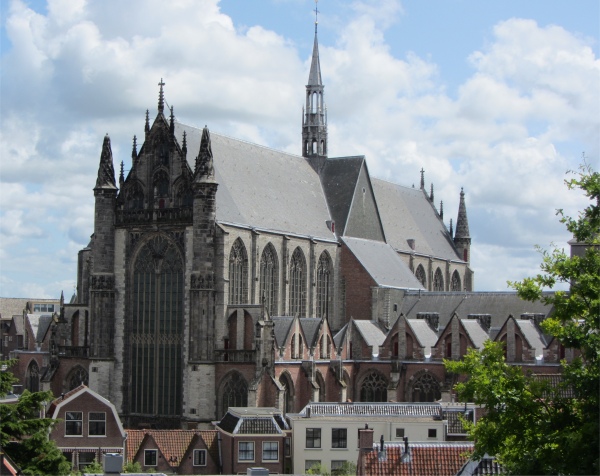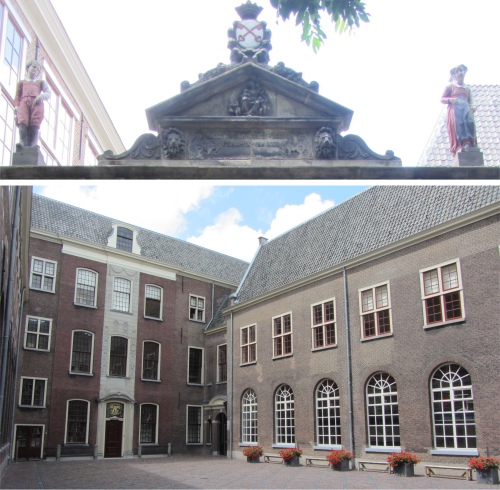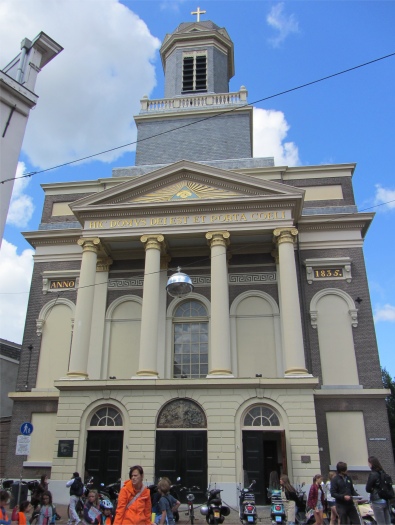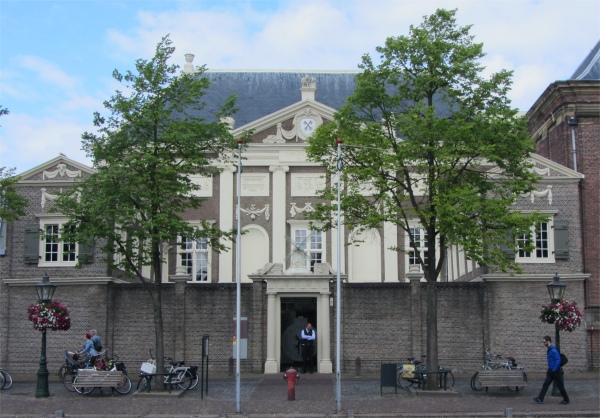 Just One of the Bike Parks by Leiden Central Station |
We set off for Leiden, catching the small ferry that operated 24x7 from the small island of Kaag over the Vaartring, and seemed to be always full of foot passengers, cyclists, cars, vans and even a lorry. Our bus stop was over on the other side next to the ferry. It was also next to a chandler. We needed some new wiper blades for the boat, and the chandler did have some, but were they the right size? The only way to find out was to go back to the boat, remove one and bring it over.
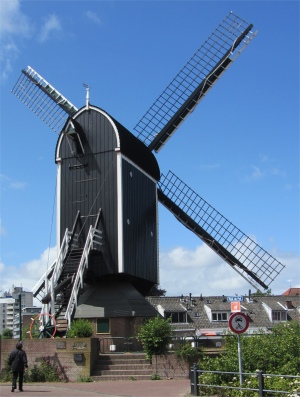 "De Put" Windmill |
I stepped out of the chandler's to see our bus speed off; we had missed it whilst inside. Never mind, we'll get the next one. I retrieved one of the wiper blades while Rex and Meryl remained in the premises. By the time I had returned Rex had bought two new ropes. Hmmm .... there had been talk of Rex making a set of reins for me to keep me out of the way of mad cyclists.
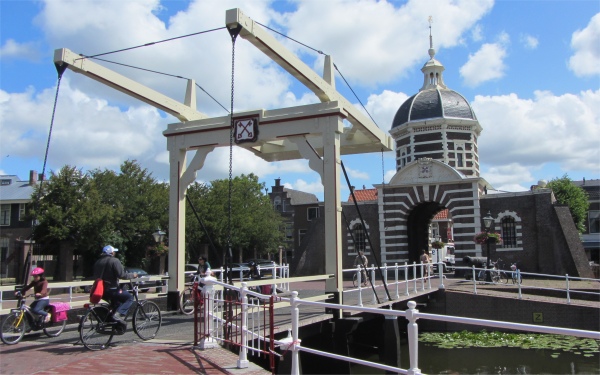 Morspoort |
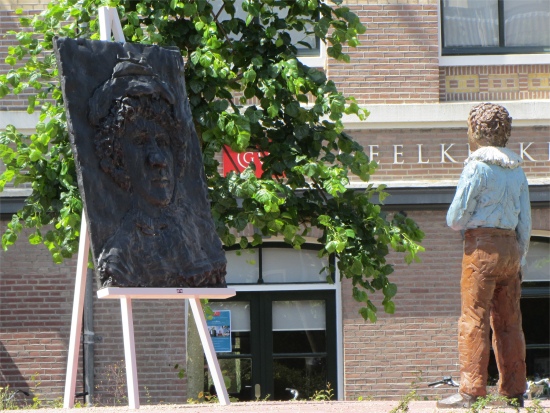 Artwork in Rembrandtplein |
Our bus did arrive eventually, and there was only one other passenger. On explaining to the driver that we wanted to get to the Nieuw-Vennep train station, we were informed that the bus did not go there. "OK, drop us off at the nearest bus stop, please," we said. We were transported through some delightful countryside, following a long straight canal for most of the way, lined with evenly spaced trees, very much like a scene from a Monet painting. Every inch of land was utilised; no space for hedges here. Boats gliding through fields betrayed the huge number of waterways criss-crossing the land. Herds of cows and sheep came into view, but the land was mainly arable, with cereal crops and legions of flowers growing. In a short while we were traversing an industrial estate and retail park in what seemed to be a brand new town. Now I will never know what went wrong with that communication with the driver, but the bus actually dropped us off at the train station.
The station was brand new too. Slick "sprinter" trains sped through, as well as Intercity lines and the Eurostar. We boarded our train and sat in a carriage that contained a fair number of students. The train whispered its way out of the station and was soon hurtling through flat countryside.
 Doelenpoort |
We looked forward to our explore of the historic university town. In the middle ages Leiden, was one of the most ancient towns in Holland, situated on the so-called Old Rhine, the sluggish waters of which flow through the town in several canal like arms. It received its city rights in 1266 and became the centre of the Dutch textile industry when the "Yperlinge" (weavers from Ypres) settled here after the great plague (1347-1350). During the 16th century Leiden sustained a terrible siege by the Spaniards, which lasted from 1573 to 1674. William the Silent caused the South dykes to be pierced, and with the country being thus inundated, he relieved the besieged by ship. According to a popular tradition Willem, the Prince of Orange offered to reward the citizens for their gallant conduct in the defence of 1574 by exempting them from the payment of taxes for a certain number of years, or by the establishment of a university in their city. The latter alternative is said to have been preferred; at all events, the prince founded the Leiden University in 1575. Its fame soon extended to every part of Europe, and it is still famous today. In the 17th century the Pilgrims lived in Leiden, the first settlers of New Amsterdam, nowadays New York, before they departed by ship to the New World.
Strolling along the pretty Galgewater, lined with renovated barges, we came across the "De Put" windmill, named after the miller Jan Jansoon Put, owner of the mill that stood here in the 17th century. It was rebuilt in the 1980s here on the north bank of the Old Rhine.
 Academiegebouw |
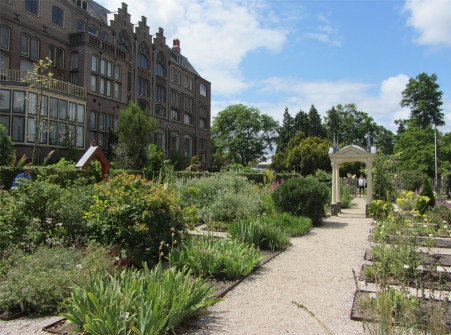 Hortus Botanicus |
 Pieterskerk |
Crossing the ubiquitous white lifting bridge by the "De Put" windmill, we entered Rembrandtplein. Rembrandt van Rijn was born in 1606 in the Weddesteeg where we stood, and he lived here until 1631. He was trained as an artist in Leiden where he produced his first masterpiece. The house where he was born was demolished at the beginning of the 20th century to allow the extension of a printing business, but a plaque set into a wall commemorates this famous artist.
We continued south until we hit the Groenhazengracht (Canal of the Green Hare), where we turned left and followed it. This canal was where the local red light district could be found in the 17th century; apparently a prostitute who lived here was nicknamed "The Green Hare". The Doelenpoort (Doelen City Gate) was located along this canal. This gate led to the training ground used by the two civic guards in Leiden. The civic guard was made up of armed citizens who defended the city in times of war, and played an important part in maintaining public order. The sandstone gate was designed in 1645 by city architect Arent van's Gravesande, and is crowned with a sculpture of St. George slaying the dragon.
The Rapenburg that we walked down became the city's most prestigious canal during the 17th century, a place where rich merchants built their houses. Along this canal we stumbled across the Academiegebouw (Academy Building). Holland's first university was founded in 1575 in Leiden. The new state of The Netherlands needed its own educational institution. The Academiegebouw was the former chapel of the Dominican nuns, and was the first building to be used by the university. It is still in use today for lectures and official occasions.
Right next to the Academiegebouw was the Hortus Botanicus. A botanical garden was established behind the Academiegebouw shortly after the founding of the university. Carolus Clusius, curator of the botanical garden in Vienna, designed the layout and planted the first tulips in Western Europe. A wisteria behind the entrance gate was planted by Clusius.
 Gravensteen |
Heading back up into the city, we stopped off at Pieterskerk, where we took a break and had a light lunch; Meryl needs regular food breaks, I am notoriously the opposite and often forget to eat. In 1121 the Count of Holland built a chapel where the church now stood, dedicating it to the apostle Peter. The Peter's Church became Leiden's first church, and has been extended many times over the centuries. The keys that Peter carries in his role as guardian of heaven's gates also appear in the coat of arms of Leiden.
Near the church was the Gravensteen, dating from the start of the 13th century, originally the prison of the Counts of Holland. In 1463 the building was transferred to the city of Leiden, and served as a city prison. From the gallery to the front of the tower, sheriffs and magistrates had a good view of the execution site, popularly known as "pure sorrow" or "the green turf".

